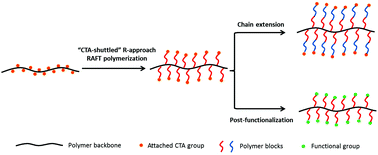A CTA-shuttled R-group approach: a versatile synthetic tool towards well-defined functional cylindrical polymer brushes via RAFT polymerization†
Abstract
We report a new synthetic route of a polymer backbone (polyCTA) containing chain transfer agent (CTA) pendent groups with a theoretical degree of polymerization (DP) up to 1200 and narrow polydispersity through reversible addition–fragmentation chain transfer (RAFT) polymerization of 4-vinylbenzyl acetate (VBA) followed by three modification steps. Well-defined cylindrical polymer brushes (CPBs) with polystyrene side chains are synthesized from the polyCTA via “CTA-shuttled” RAFT polymerization to prove the feasibility. Furthermore, various post-functionalizations on CPBs are investigated to demonstrate the potential of building complex architectures. CPBs with polystyrene-b-poly(N-isopropylacrylamide) side chains, amine-terminated polystyrene side chains and polystyrene-b-poly(ethylene glycol) side chains are synthesized successfully by the direct chain extension of N-isopropylacrylamide, one-pot aminolysis and Michael addition using acrylates containing a tert-butoxy carbonyl (Boc) protected amine group or mono-methyl poly(ethylene glycol), respectively. The strategy of “CTA-shuttled” R-group approach RAFT polymerization along with post-functionalization exhibits versatility in preparing tailor-made CPBs.



 Please wait while we load your content...
Please wait while we load your content...